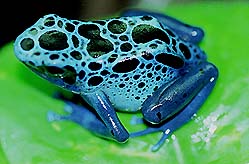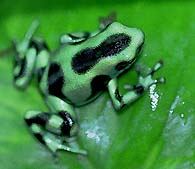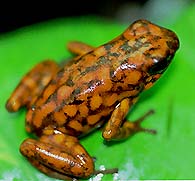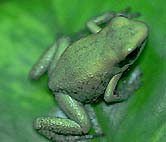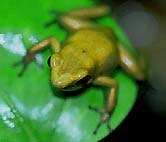Poison dart frog
| Poison dart frog Dendrobates, Phyllobates Poison dart frogs belong to the Dendrobatidae family. An interesting fact is that they gather their toxins from the bugs they eat. And, in turn, they use the poisons to kill their enemies. |
These unique frogs live in parts of Central and South America. They are brightly colored in red, yellow or orange and often they have bold stripes or crossbars. Very small in size (reaching only 2-5 cm in length) and weighting only a few grams, they seem helpless. However, their skin glands produce one of the strongest toxins in the animal world: batrachotoxin, from the ancient Greek word batrachosfrogs and toxinpoison). The name was given by the American scientists John Delly and Bernard Whitcup who carried out several tests to determine the action of this powerful toxin.
Most amphibian skin toxins are complex nitrogenous compounds that affect the victim in different ways. Some can cause local irritation only, others provoke hallucinations or act as vasoconstrictors, ones that contract blood vessels. |
|
There are also neurotoxins, which affect the nervous system. Batrachotoxin, in particular, is a nerve poison. Only a drop of this substance that has entered the victims body can block the transmission of nerve impulses and the heart may stop functioning.Spiders are often attracted by the beautiful dart frogs and try to kill them in an approach. However, it is too late: the poison released by the frogs skin glands located on the back and around the ears has fulfilled its purpose. The spider dies and is already a suitable meal for the frog. When this small amphibian feels threatened (if touched by a human hand or bitten by a carnivorous animal), its poison glands reflexively expel the toxin through a number of canals. The substance has a specific smell and bitter, peppery taste that causes vomiting. Therefore, the animal that has bitten the frog soon needs to let it out of its mouth. Poison dart frogs also feed on other insects, centipedes and worms. They are a very important part of the ecosystem because they control the population of various pests.
The habitat of arrow-frogs is restricted to warm parts of Latin America, where the humidity level is very high, about 80%. They are mostly arboreal animals climbing trees very easily by virtue of their adhering disks at the end of the fingers. They seldom go to water pools except for reproduction. Poison dart frogs lay their eggs in lukewarm pools of water at the brim of leaves, where the eggs are in a secure place, high in the canopy.
|
|
There are 10 species in the genus Dendrobates. They are all brightly colored: Dendrobates azureus is blue and Dendrobates auratus, which lives in Costa Rica, is green, with regular black spots. A very small species is Dendrobatespumilioin fact it reaches only 1.8 cm in length and is the smallest member of the family. Its back is brightly orange to red and has tiny darker spots; the limbs are black.
There are several species with very strong poison in the genus Phyllobates. Phyllobates terribilis, which is the most toxic frog from all arrow-frogs, belongs to this genus.
Since ancient times local Indians have known the effect of these poisons and used them for hunting, combats with enemy tribes and in the defense from the European invaders. The Embera Choco people, South American natives from the rainforests of Columbia, have long depended on the poison dart frogs. They are famous for the crafting of the so-called dart guns. Darts coated with the potent toxin of Phyllobates terribilis were swiftly blown at birds and other animals through a blowshaft. This effective method of hunting has been practiced for centuries and is part of the ancient traditions of local people. |
|
The poison of dart frogs is a subject of scientific research. First, there are several species of snakes in South America that eat these frogs and are not affected by it. Therefore, an arising question is how certain animals can be resistant to batrachotoxin. What is more, the strong poison makes it possible for scientists to investigate how nervous impulses are transmitted in animal organisms, and why not in the human ones. Scientists have discovered that batrachotoxin does not immediately block the nervous system; at first, it makes the contractions of the heart muscle stronger. Researchers claim that the pumiliotoxin released by Dendrobates auratus might be used as a cardiac stimulant after a heart attack. According to the National Institute of Health, poison dart frogs offer over 300 alkaloid componentschemicals that are similar to cocaine and morphine and can be used for medical purposes. Some medicines produced on the basis of batrachotoxin are already being used as anesthetics in surgery.

